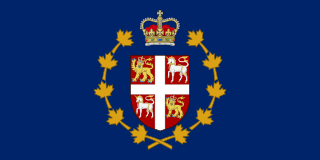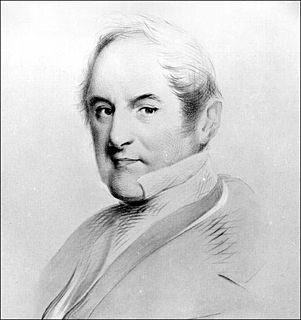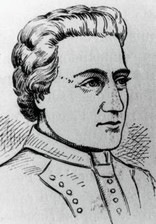See also
| Political offices | ||
|---|---|---|
| Preceded by Thalour Du Perron | Governor of Plaisance 1664–1667 | Succeeded by La Palme |
Lafontaine Bellot (Bellot dit Lafontaine) was Governor of Plaisance (Placentia), Newfoundland from 1664 to 1667.
Bellot was in charge of a small fort and garrison that protected the interests of the French fishery in the area. He was an ineffective governor who misused his power and was recalled in 1667.
| Political offices | ||
|---|---|---|
| Preceded by Thalour Du Perron | Governor of Plaisance 1664–1667 | Succeeded by La Palme |

Newfoundland and Labrador is the easternmost province of Canada, in the country's Atlantic region. It is composed of the island of Newfoundland and the continental region of Labrador to the northwest, with a combined area of 405,212 square kilometres (156,500 sq mi). In 2018, the province's population was estimated at 525,073. About 92% of the province's population lives on the island of Newfoundland, of whom more than half live on the Avalon Peninsula.

The Province of Canada was a British colony in North America from 1841 to 1867. Its formation reflected recommendations made by John Lambton, 1st Earl of Durham, in the Report on the Affairs of British North America following the Rebellions of 1837–1838.
Lafontaine, French for "the fountain", may refer to:

The Lieutenant Governor of Newfoundland and Labrador is the viceregal representative in Newfoundland and Labrador of the Canadian monarch, Queen Elizabeth II, who operates distinctly within the province but is also shared equally with the ten other jurisdictions of Canada, as well as the other Commonwealth realms and any subdivisions thereof, and resides predominantly in her oldest realm, the United Kingdom. The Lieutenant Governor of Newfoundland and Labrador is appointed in the same manner as the other provincial viceroys in Canada and is similarly tasked with carrying out most of the monarch's constitutional and ceremonial duties. The current, and 14th, Lieutenant Governor of Newfoundland and Labrador is Judy Foote, who has served in the role since 3 May 2018.

Lieutenant-General Sir John Harvey, was a British Army officer and a lieutenant governor.

Admiral Richard Edwards naval officer and colonial governor of Newfoundland.

Daniel d'Auger de Subercase was a naval officer and the French governor of Newfoundland and later Acadia.
Joseph de Monic military officer and administrator, acting Governor of Newfoundland, born Oloron, Béarn died Bayonne.
Jacques-François de Monbeton de Brouillan French military officer and Governor of Plaisance (Placentia), Newfoundland (1689-1701) and Acadia (1701-1705).
Louis de Pastour de Costebelle naval officer served as interim governor of Plaisance (Placentia), Newfoundland, before the arrival of Jacques-François de Monbeton de Brouillan in 1690. Costebelle came to Newfoundland as head of a detachment of soldiers in 1687.

By the arrangements of the Canadian federation, the Canadian monarchy operates in Newfoundland and Labrador as the core of the province's Westminster-style parliamentary democracy. As such, the Crown within Newfoundland and Labrador's jurisdiction is referred to as the Crown in Right of Newfoundland and Labrador, Her Majesty in Right of Newfoundland and Labrador, or the Queen in Right of Newfoundland and Labrador. The Constitution Act, 1867, however, leaves many royal duties in Newfoundland and Labrador specifically assigned to the sovereign's viceroy, the Lieutenant Governor of Newfoundland and Labrador, whose direct participation in governance is limited by the conventional stipulations of constitutional monarchy.
Antoine Parat was Governor of Plaisance (Placentia), Newfoundland from 1685 to 1690.
The Sieur de la Palme was the Governor of Plaisance in the New-France colony in Newfoundland from 1667 to 1670.
Nicolas Gargot de La Rochette was Governor of Plaisance (Placentia), Newfoundland in 1660. The post was left vacant until 1662.
Sieur de Kéréon was the first French Governor of Plaisance (Placentia), Newfoundland in 1655. The post was left vacant until 1660.
Thalour Du Perron was Governor of Plaisance (Placentia), Newfoundland from 1662 to 1664.

The history of Newfoundland and Labrador covers the period of time from the arrival of the Archaic peoples, Prior to European colonization, the lands encompassing present-day Newfoundland and Labrador were inhabited for millennia by different groups of indigenous peoples.
Bellot may refer to:

Newfoundland Colony was an English and, later, British colony established in 1610 on the island of Newfoundland off the Atlantic coast of Canada, in what is now the Canadian province of Newfoundland and Labrador. That followed decades of sporadic English settlement on the island, which was at first seasonal, rather than permanent. It was made a Crown colony in 1824 and a Dominion in 1907. Its economy collapsed during the Great Depression, and Newfoundland relinquished its dominion status, becoming once again a Crown colony governed by appointees from the Colonial Office in Whitehall in London. In 1949, the colony voted to join Canada as the Province of Newfoundland. In 2001, its name was officially changed to Newfoundland and Labrador.